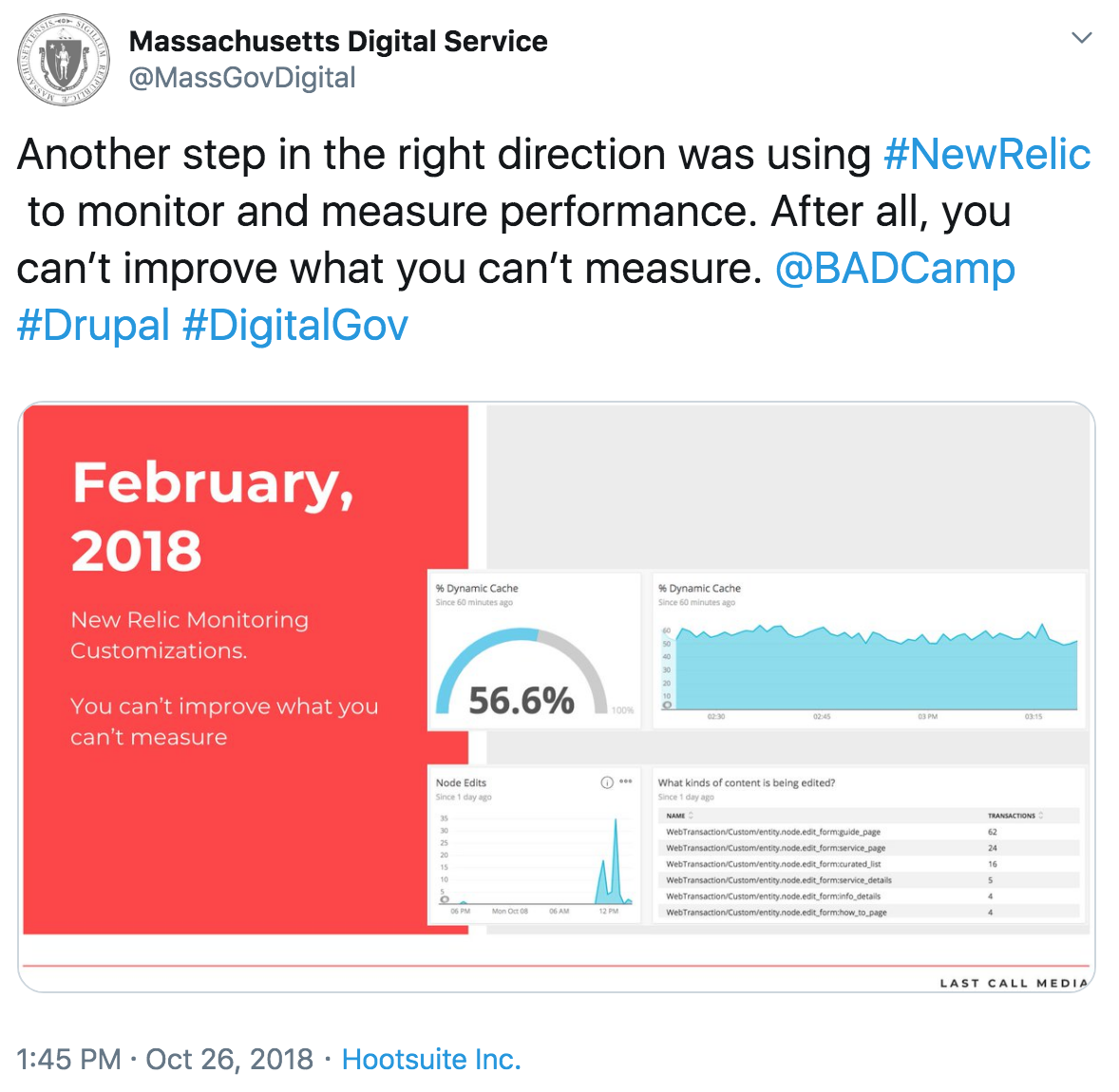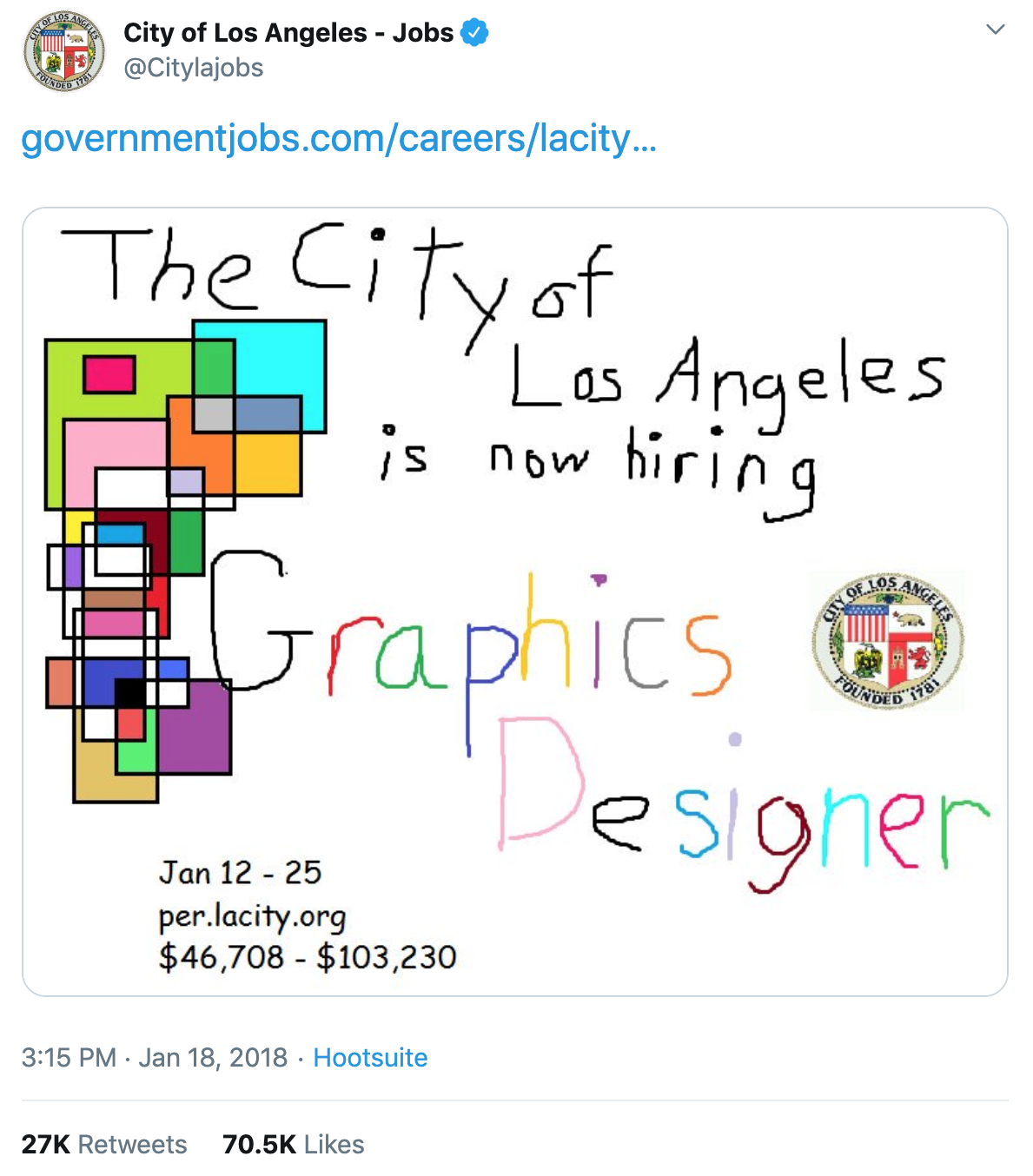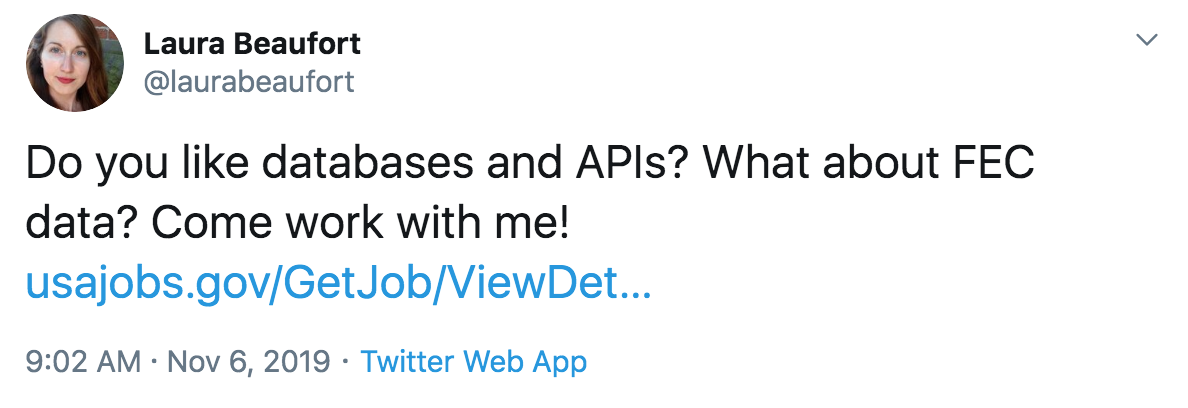Recruiting
Nurture your reputation
Building a reputation as an organization committed to digital talent takes time. To attract the best talent, make recruiting an ongoing activity — not just one that you engage in when you have a job opening. Here are some basic things you can be doing all the time to build your reputation.
Maintain an online presence. Talk about the work you do. You can do this through:
Share details about your culture, benefits, and commitment to staff (not just the mechanics of the work you do). When you speak and write, emphasize what makes your team unique.
Be active in the civic technology community. Encourage members of your team to attend and speak at conferences, meetups, and other events. When the time comes to hire, the caliber of candidates will reflect your authentic engagement with the community.
For more details, see the building a movement and a presence section.
Write an appealing position description
Use plain language
Government is full of jargon. It’s likely that candidates outside of government could bring useful skills and experience. To access these potential candidates, you’ll need to make sure they can understand what you’re looking for.
Attract outside applicants
Do your research to make sure that your job description will get in front of the right people. For example, use job titles like those found outside government. More job seekers are likely to understand a post for “Software Engineer” more than one for an “IT Specialist APPSW.”
Look at job postings outside of government and write position descriptions that mirror them. Industry applicants will find these more familiar.
Be selective about your must-haves
Too often, job descriptions list every single technology under the sun. Narrow the list down to the skills you really need. For example, if you’re willing to train someone to use InVision, experience with InVision isn’t required for candidates.
Shorter, more realistic requirements lists show that you understand what you need. And they’ll also bring in a more diverse applicant pool.
Men are willing to apply to jobs for which they meet only 60% of the qualifications, women are much more likely to hesitate unless they meet 100% of the listed requirements.
Tara Sophia Mohr, Why Women Don't Apply for Jobs Unless They're 100% Qualified
Sections of a position description
The following position description outline is adapted from 18F’s position descriptions:
- Location
- Salary range and benefits
- Who may apply (citizens, existing employees, the public, etc.)
- Short mission statement and role summary
- 3 to 5 key objectives for the role
- How applications will be evaluated
- A distilled list of the top priority qualifications
In addition to most of the sections above, you can consider adding what the new hire will do in one, three, six, and 12 months. This is especially effective for roles that are shorter-term “tours of duty” in the government. This also reassures candidates that you have meaningful work for them right away.
You can write your position descriptions based on existing, similar descriptions. Check these job boards or organizations for inspiration:
- https://join.tts.gsa.gov/
- https://digitalservices.georgia.gov/careers
- https://digitalservices.sfgov.org/joinus/
Companies that work almost exclusively with government can also be a good reference for civic-oriented job postings. Here are some examples:
Resources
- Textio can help you write better, more inclusive position descriptions
- Hemingway App makes your writing clearer
- 5 Must-Do’s for Writing Inclusive Job Descriptions
- Why Women Don’t Apply for Jobs Unless They’re 100% Qualified
- Tools for government hiring
- Improving the Hiring Process
Attract candidates new to government
Government often can’t compete with industry on salary. To counter this, lead with a strong mission statement and focus on the agency’s impact.
The San Francisco Digital Services website does this well with a concise paragraph:
We’re working on critical issues like affordable housing, small businesses, legal aid for immigrants, and more. Our team is also building the city’s website from the ground up.
The first sentence refers to impactful critical issues that are part of the city’s mission. This draws the applicant in. A job description for a product manager similarly describes the mission aspect first:
You will engage with permitting departments and customers to understand where there is greatest need and opportunity, and you will own the overall product roadmap for digital permitting.
Anyone who’s tried to get a permit with the city will want to work on making that process better.
Candidates like hearing about what they’ll be working on. Include short descriptions of the projects (or similar ones) they’ll be working on. These can be simple descriptions, such as:
Our team is also building the city’s website from the ground up.
Advertise your job opening
Don’t expect to put a job opening online on your government website and have lots of great candidates apply. To ensure that you attract a qualified and diverse candidate pool, you’ll need to advertise your job opening.
Post your job opening online
In addition to posting your job in the official government listing, post jobs where candidates are. The more people who see or hear about your job opening, the more likely you are to have the right candidates apply. Here are key places to post:
- Indeed
- Design Gigs for Good
- Public Interest Tech Job Board by Code for America
- Tech Jobs for Good
- Slack communities (for example, DCTech)
The following boards help reach candidates who are often under-represented in technology:
Get everyone you know to use their social media channels to spread the word about your job opening on Twitter, LinkedIn, and Facebook. You can help by providing text people can copy and paste. These messages can be simple, like the examples below:



Attend meetups and other events
In addition to posting your job opening online, consider attending events and meetups to personally invite candidates to apply. Here are some resources to give you ideas on where to go:
- Local Code for America Brigade
- Modern tech meetups on topics such as Python, Open Source, JavaScript, DevOps, Agile, Salesforce, and Cloud
Going in-person provides the opportunity to talk passionately about the work you do. It also allows prospective applicants to meet the people they’ll be working with. Emphasize that they’ll be in a supportive team environment and not the lone technologist.
In addition, by encouraging your team to attend technology meetups you allow them to (1) recruit and (2) continuously learn new things.
Resources
Consider remote employees
Consider hiring remote employees. Recruiting and hiring is easier when you don’t restrict the talent search to the city where the work is.
By 2028, 73% of all departments will have remote workers.
Upwork, Future Workforce Report
Here are some of the benefits of opening the search to remote candidates:
- You can often find strong talent in less competitive markets
- You can hire talent that’s unwilling or unable to relocate, expanding your choices
- Teams distributed across multiple time zones offer a longer overall workday on projects
Engage candidates throughout the process
Government hiring processes can take a long time. Explain clearly on your website what the hiring process is like, from when candidates apply to their first day on the job. Include how long each step takes on average. Timelines help set expectations and might discourage candidates from applying or accepting elsewhere while they wait.
The General Service Administration’s Technology Transformation Service does this well on their jobs page, for example:
| Process Stage | Average Duration/Days |
|---|---|
| Application collection | 5 |
| TTS application review | 5 |
| GSA HR application review | 10 |
| Interviews | 30 |
| Offer and security | 30 to 60 |
| Total from application to start | 80 to 110 |
The City of San Francisco has a very high-touch hiring process. They require that someone is in touch with candidates at least once a week.
We have gotten feedback from a lot of candidates that this was a really great interaction with government, pleasantly surprised by high-touch experience.
Deputy Chief Digital Officer
Reduce the hiring time
Government hiring processes can take months — six months isn’t unusual. For candidates who are used to industry timelines, this is an eternity. You risk losing valuable candidates to a long process, especially if there’s no communication between the stages. Shorter hiring processes also mean you’ll bring necessary staff on board sooner.
To shorten the hiring process:
- Work with HR to map the current hiring process
- Identify areas of improvement with the goal of reducing the overall hiring time
- Make a plan to do this regularly
- Work with HR so that you can communicate with the candidates throughout the process
The HR department may not have the metrics you’re looking for, so the first step might be measuring how long each step in the process takes.
Resources
Checklist
- Write an appealing position description
- Use plain language
- Job titles and descriptions should be comparable to those outside government
- Limit lists of requirements to must-haves
- Attract candidates new to government
- Lead job descriptions with a strong mission statement
- Include descriptions of projects candidates will be working on
- Advertise your job opening
- Post your opening online to where the candidates are
- Use social media to spread the word about the opening
- Attend local meetups and other events to invite people to attend
- Consider hiring remote employees to expand your talent pool
- Engage candidates throughout the process
- Explain your hiring process clearly on your website, including expected timeframes for each stage
- Communicate regularly with candidates throughout the process
- Reduce the hiring time
- Work with your HR department to map the hiring process
- Identify and improve parts of the process that can be streamlined
Case study: City and County of San Francisco
One might think that the overwhelming amount of digital talent in the Bay Area makes it easy to recruit for the San Francisco Digital Service. In fact, they face the same recruitment challenges as digital teams in state and local governments across the country. And they’re competing against top tech companies that pay much higher salaries than local government.
To ease and streamline their recruiting process, the SF Digital Service team:
- Builds relationships with HR staff so that they understand new technical roles and why a different hiring process is sometimes necessary
- Helps out with outreach, recruiting, and interviewing
- Uses a high-touch model, reaching out to prospective hires at least once a week to guide them through the process
- Tracks hiring metrics like passthrough rates, time-to-hire, and acceptance rates using modern applicant tracking software
- Sets candidate expectations for salary, work environment, and government culture up front, increasing the acceptance rate for job offers